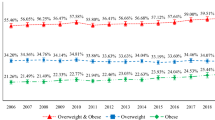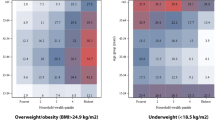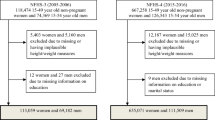Abstract
Background/Objectives
Previous studies about obesity and its associated factors in low- and middle-income countries have been based mostly on women of reproductive age. Furthermore, disproportionally changing BMI distributions have been a challenge for its appropriate modeling. In this context, we assessed the magnitude and rate of change in BMI distribution by socioeconomic and geographic factors in both sexes in Latin American countries, modeling the shape of BMI distributions.
Subjects/Methods
We used data from national surveys conducted in Mexico, Colombia, and Peru at two time points between 2005 and 2013 (N = 57,414, 13,5403, and 30,811, respectively). We estimated shapes of BMI distributions for 2005 and 2010, and assessed their changes, using the generalized additive model for location, scale, and shape (GAMLSS), in which BMI was assumed to follow a Box-Cox Power Exponential (BCPE) distribution.
Results
In all the three countries, higher education was negatively associated with BMI in women but somewhat positive in men; and household wealth was positively associated in men but not in women. Lower household wealth was associated with higher rates of change in BMI distributions in women.
Conclusion
Education and household wealth were associated with BMI distributions and their change over time. Observed sex differences in these associations have implications for designing relevant policies and programs to approach target populations effectively. The BCPE-GAMLSS method can provide a useful visual assessment of time-varying measures.
This is a preview of subscription content, access via your institution
Access options
Subscribe to this journal
Receive 12 print issues and online access
$259.00 per year
only $21.58 per issue
Buy this article
- Purchase on Springer Link
- Instant access to full article PDF
Prices may be subject to local taxes which are calculated during checkout




Similar content being viewed by others
References
Institute for Health Metrics and Evaluation. Global Burden of Disease Study 2015 (GBD 2015) Obesity and Overweight Prevalence 1980–2015. Seattle, USA; 2017.
Dinsa GD, Goryakin Y, Fumagalli E, Suhrcke M. Obesity and socioeconomic status in developing countries: a systematic review. Obes Rev 2012;13:1067–79.
Neuman M, Finlay JE, Smith GD, Subramanian SV. The poor stay thinner: stable socioeconomic gradients in BMI among women in lower- and middle-income countries. Am J Clin Nutr 2011;94:1348–57.
Mamun AA, Finlay JE. Shifting of undernutrition to overnutrition and its determinants among women of reproductive ages in the 36 low to medium income countries. Obes Res Clin Pract 2015;9:75–86.
Jones-Smith JC, Gordon-Larsen P, Siddiqi A, Popkin BM. Is the burden of overweight shifting to the poor across the globe? Time trends among women in 39 low- and middle-income countries (1991–2008). Int J Obes 2012;36:1114–20.
Popkin BM, Adair LS, Ng SW. Global nutrition transition and the pandemic of obesity in developing countries. Nutr Rev 2012;70:3–21.
Kanter R, Caballero B. Global gender disparities in obesity: a review. Adv Nutr 2012;3:491–8.
Flegal KM, Carroll MD, Kit BK, Ogden CL. Prevalence of obesity and trends in the distribution of body mass index among US adults, 1999–2010. Jama 2012;307:491–7.
Sperrin M, Marshall AD, Higgins V, Buchan IE, Renehan AG. Slowing down of adult body mass index trend increases in England: a latent class analysis of cross-sectional surveys (1992-2010). Int J Obes 2014;38:818–24.
Razak F, Corsi DJ, Subramanian SV. Change in the body mass index distribution for women: analysis of surveys from 37 low- and middle-income countries. PLoS Med 2013;10:e1001367.
Olaiz-Fernández G, Rivera-Dommarco J, Shamah-Levy T, Rojas R, Villalpando-Hernández S, Hernández-Avila M, et al. Encuesta Nacional de Salud y Nutrición 2006. Cuernavaca, Mexico: Instituto Nacional de Salud Pública (INSP); 2006.
Gutiérrez JP, Rivera-Dommarco J, Shamah-Levy T, Villalpando-Hernández S, Franco A, Cuevas-Nasu L, et al. Encuesta Nacional de Salud y Nutrición 2012. Resultados nacionales. 2nd ed. Cuernavaca, Mexico: Instituto Nacional de Salud Pública (INSP); 2013.
Profamilia, Macro International. Salud Sexual y Reproductive. Resultados: Encuesta Nacional de Demografía y Salud 2005. Bogotá, Colombia: Profamilia, and Calverton, USA: Macro International; 2005.
Profamilia, ICF Macro. Encuesta Nacional de Demografía y Salud, ENDS 2010. Bogotá, Colombia: Profamilia, and Calverton, USA: ICF Macro; 2011.
Centro Nacional de Alimentación y Nutrición (CENAN), Instituto Nacional de Estadística e Informática (INEI). Informe Final: perfil nutricional y pobreza en Perú. ENAHO I trimestre 2008. Lima, Peru: CENAN and INEI; 2009.
Dirección Ejecutiva de vigilancia Alimentaria y Nutricional (DEVAN). Informe técnico: estado nutricional en el Perú por etapas de vida; 2012-2013. Lima, Peru: DEVAN; 2015.
The DHS Program, ICF International. Wealth Index Construction.
Fry K, Firestone R, Chakraborty NM Measuring equity with nationally representative wealth quintiles. Washington, DC, USA: PSI; 2014.
Rigby RA, Stasinopoulos DM. Smooth centile curves for skew and kurtotic data modelled using the Box-Cox power exponential distribution. Stat Med 2004;23:3053–76.
Majer IM, Mackenbach JP, van Baal PH. Time trends and forecasts of body mass index from repeated cross-sectional data: a different approach. Stat Med 2013;32:1561–71.
World Health Organization (WHO). WHO child growth standards: length/height-for-age, weight-for-age, weight-for-length, weight-for-height and body mass index-for-age: methods and development. Geneva, Switzerland: WHO; 2006.
Yamada G, Castillo-Salgado C, Jones-Smith JC, Moulton LH. Differences in magnitude and rate of change in adult obesity distribution by age and sex in Mexico, Colombia and Peru, 2005–2010. Public Health Nutr 2019;22:757–63.
Rigby RA, Stasinopoulos DM. Generalized additive models for location, scale and shape. J R Stat Soc Ser C Appl Statist 2005;54:507–54.
Kolenikov S. Resampling variance estimation for complex survey data. Stata J 2010;10:165–99.
Monteiro CA, Conde WL, Popkin BM. Income-specific trends in obesity in Brazil: 1975-2003. Am J Public Health. 2007;97:1808–12.
Quezada AD, Lozada-Tequeanes AL. Time trends and sex differences in associations between socioeconomic status indicators and overweight-obesity in Mexico (2006–2012). BMC Public Health. 2015;15:1242–4.
Basto-Abreu A, Barrientos-Gutierrez T, Zepeda-Tello R, Camacho V, Gimeno Ruiz de Porras D, Hernandez-Avila M. The relationship of socioeconomic status with body mass index depends on the socioeconomic measure used. Obesity. 2018;26:176–84.
Kasper NM, Herran OF, Villamor E. Obesity prevalence in Colombian adults is increasing fastest in lower socio-economic status groups and urban residents: results from two nationally representative surveys. Public Health Nutr 2014;17:2398–406.
Jacoby E, Goldstein J, Lopez A, Nunez E, Lopez T. Social class, family, and life-style factors associated with overweight and obesity among adults in Peruvian cities. Prev Med 2003;37:396–405.
Alvarez-Dongo D, Sanchez-Abanto J, Gomez-Guizado G, Tarqui-Mamani C. Overweight and obesity: prevalence and determining social factors of overweight in the Peruvian population (2009–2010). Rev Peru Med Exp Salud Publica 2012;29:303–13.
Goryakin Y, Suhrcke M. Economic development, urbanization, technological change and overweight: what do we learn from 244 Demographic and Health Surveys? Econ Hum Biol 2014;14:109–27.
Wells JCK. Sexual dimorphism of body composition. Best Pr Res Clin Endocrinol Metab 2007;21:415–30.
Aitsi-Selmi A, Bell R, Shipley MJ, Marmot MG. Education modifies the association of wealth with obesity in women in middle-income but not low-income countries: an interaction study using seven national datasets, 2005-2010. PLoS ONE 2014;9:e90403.
Galobardes B, Shaw M, Lawlor DA, Lynch JW, Smith GD. Indicators of socioeconomic position (part 1). J Epidemiol Community Health 2006;60:7–12.
Quispe R, Benziger CP, Bazo-Alvarez JC, Howe LD, Checkley W, Gilman RH, et al. The Relationship Between Socioeconomic Status and CV Risk Factors: The CRONICAS Cohort Study of Peruvian Adults. Glob Heart 2016;11:121–30.e2.
Van Hook J, Altman CE, Balistreri KS. Global patterns in overweight among children and mothers in less developed countries. Public Health Nutr. 2013;16:573–81.
Acknowledgements
We would like to thank Dr. Teresa Shamah-Levy and her colleagues at National Institute of Public Health, Mexico, and Dr. Jaime Miranda and Dr. Rodrigo Carrillo-Larco at Universidad Peruana Cayetano Heredia, for providing us information about survey methods used in conducting national health and nutritional surveys. We also thank Mr. Mark Miller at Joint High Performance Computing Exchange (JHPCE) Cluster, Johns Hopkins Bloomberg School of Public Health, for facilitating and troubleshooting the use of the cluster computer system.
Funding
This research received any specific grant from funding agencies in the public, commercial, or not-for-profit sectors.
Author information
Authors and Affiliations
Contributions
GY formulated the research question, designed the study, carried out data analysis, and prepared the first draft. JCJS and CCS provided intellectual guidance and inputs in formulating the research question, designing the study, interpreting results, and writing the manuscript. LHM supervised the entire procedure and provided intellectual inputs at each step of this study.
Corresponding author
Ethics declarations
Conflict of interest
The authors declare that they have no conflict of interest.
Ethical approval
This study was reviewed by the Johns Hopkins Bloomberg School of Public Health Institutional Review Board and considered as secondary analyses of existing, de-identified and de-linked databases.
Additional information
Publisher’s note: Springer Nature remains neutral with regard to jurisdictional claims in published maps and institutional affiliations.
Supplementary information
Rights and permissions
About this article
Cite this article
Yamada, G., Jones-Smith, J.C., Castillo-Salgado, C. et al. Differences in magnitude and rates of change in BMI distributions by socioeconomic and geographic factors in Mexico, Colombia, and Peru, 2005–2010. Eur J Clin Nutr 74, 472–480 (2020). https://doi.org/10.1038/s41430-019-0479-9
Received:
Accepted:
Published:
Issue Date:
DOI: https://doi.org/10.1038/s41430-019-0479-9



